Impacts of a Prescribed Fire on Air Quality in Central New Mexico
Abstract
:1. Introduction
2. Materials and Methods
3. Results and Discussion
4. Conclusions
Author Contributions
Funding
Institutional Review Board Statement
Informed Consent Statement
Data Availability Statement
Acknowledgments
Conflicts of Interest
References
- Jaffe, D.A.; O’Neill, S.M.; Larkin, N.K.; Holder, A.L.; Peterson, D.L.; Halofsky, J.E.; Rappold, A.G. Wildfire and prescribed burning impacts on air quality in the United States. J. Air Waste Manag. Assoc. 2020, 70, 583–615. [Google Scholar] [CrossRef] [PubMed]
- Altshuler, S.L.; Zhang, Q.; Kleinman, M.T.; Garcia-Menendez, F.; Moore, C.T.; Hough, M.L.; Stevenson, E.D.; Chow, J.C.; Jaffe, D.A.; Watson, J.G. Wildfire and prescribed burning impacts on air quality in the United States. J. Air Waste Manag. Assoc. 2020, 70, 961–970. [Google Scholar] [CrossRef] [PubMed]
- Westerling, A.; Hidalgo, H.; Cayan, D.; Swetnam, T. Warming and earlier spring increase western US forest wildfire activity. Science 2006, 313, 940–943. [Google Scholar] [CrossRef]
- Abatzoglou, J.T.; Williams, A.P. Impact of anthropogenic climate change on wildfire across western US forests. Proc. Natl. Acad. Sci. USA 2016, 113, 11770–11775. [Google Scholar] [CrossRef]
- Elahi, E.; Khalid, Z.; Tauni, M.Z.; Zhang, H.; Lirong, X. Extreme weather events risk to crop-production and the adaptation of innovative management strategies to mitigate the risk: A retrospective survey of rural Punjab, Pakistan. Technovation 2022, 117, 102255. [Google Scholar] [CrossRef]
- Bowman, D.; Kolden, C.A.; Abatzoglou, J.T.; Johnston, F.H.; van der Werf, G.R.; Flannigan, M. Vegetation fires in the Anthropocene. Nat. Rev. Earth Environ. 2020, 1, 500–515. [Google Scholar] [CrossRef]
- McMeeking, G.; Kreidenweis, S.; Carrico, C.; Lee, T.; Collett, J.; Malm, W. Observations of smoke-influenced aerosol during the Yosemite Aerosol Characterization Study: Size distributions and chemical composition. J. Geophys. Res. Atmos. 2005, 110. [Google Scholar] [CrossRef]
- Naeher, L.P.; Brauer, M.; Lipsett, M.; Zelikoff, J.T.; Simpson, C.D.; Koenig, J.Q.; Smith, K.R. Woodsmoke health effects: A review. Inhal. Toxicol. 2007, 19, 67–106. [Google Scholar] [CrossRef]
- Malm, W.C.; Sisler, J.F.; Huffman, D.; Eldred, R.A.; Cahill, T.A. Spatial and Seasonal Trends in Particle Concentration and Optical Extinction in the United States. J. Geophys. Res. Atmos. 1994, 99, 1347–1370. [Google Scholar] [CrossRef]
- IPCC. Climate Change 2021: The Physical Science Basis. In Contribution of Working Group I to the Sixth Assessment Report of the Intergovernmental Panel on Climate Change; Masson-Delmotte, V., Zhai, P., Pirani, A., Connors, S., Péan, C., Berger, S., Caud, N., Chen, Y., Goldfarb, L., Gomis, M., Huang, M., Leitzell, K., Lonnoy, E., Matthews, J., Maycock, T., Waterfield, T., Yelekçi, O., Yu, R., Zhou, B., Eds.; Cambridge University Press: Cambridge, UK; New York, NY, USA, 2021. [Google Scholar]
- Ryan, K.C.; Knapp, E.E.; Varner, J.M. Prescribed fire in North American forests and woodlands: History, current practice, and challenges. Front. Ecol. Environ. 2013, 11, E15–E24. [Google Scholar] [CrossRef]
- Schoennagel, T.; Balch, J.K.; Brenkert-Smith, H.; Dennison, P.E.; Harvey, B.J.; Krawchuk, M.A.; Mietkiewicz, N.; Morgan, P.; Moritz, M.A.; Rasker, R.; et al. Adapt to more wildfire in western North American forests as climate changes. Proc. Natl. Acad. Sci. USA 2017, 114, 4582–4590. [Google Scholar] [CrossRef]
- Andreae, M.O.; Merlet, P. Emission of trace gases and aerosols from biomass burning. Glob. Biogeochem. Cycles 2001, 15, 955–966. [Google Scholar] [CrossRef]
- McMeeking, G.; Kreidenweis, S.; Baker, S.; Carrico, C.; Chow, J.; Collett, J.; Hao, W.; Holden, A.; Kirchstetter, T.; Malm, W.; et al. Emissions of trace gases and aerosols during the open combustion of biomass in the laboratory. J. Geophys. Res. Atmos. 2009, 114. [Google Scholar] [CrossRef]
- Bond, T.C.; Doherty, S.J.; Fahey, D.W.; Forster, P.M.; Berntsen, T.; DeAngelo, B.J.; Flanner, M.G.; Ghan, S.; Karcher, B.; Koch, D.; et al. Bounding the role of black carbon in the climate system: A scientific assessment. J. Geophys. Res. Atmos. 2013, 118, 5380–5552. [Google Scholar] [CrossRef]
- Gomez, S.; Carrico, C.; Allen, C.; Lam, J.; Dabli, S.; Sullivan, A.; Aiken, A.; Rahn, T.; Romonosky, D.; Chylek, P.; et al. Southwestern US Biomass Burning Smoke Hygroscopicity: The Role of Plant Phenology, Chemical Composition, and Combustion Properties. J. Geophys. Res. Atmos. 2018, 123, 5416–5432. [Google Scholar] [CrossRef]
- Liu, Y.Q.; Goodrick, S.; Heilman, W. Wildland fire emissions, carbon, and climate: Wildfire-climate interactions. For. Ecol. Manag. 2014, 317, 80–96. [Google Scholar] [CrossRef]
- Rocca, M.E.; Brown, P.M.; MacDonald, L.H.; Carrico, C.M. Climate change impacts on fire regimes and key ecosystem services in Rocky Mountain forests. For. Ecol. Manag. 2014, 327, 290–305. [Google Scholar] [CrossRef]
- Nelson, J.; Chalbot, M.C.G.; Tsiodra, I.; Mihalopoulos, N.; Kavouras, I.G. Physicochemical Characterization of Personal Exposures to Smoke Aerosol and PAHs of Wildland Firefighters in Prescribed Fires. Expo. Health 2021, 13, 105–118. [Google Scholar] [CrossRef]
- Price, O.F.; Horsey, B.; Jiang, N.B. Local and regional smoke impacts from prescribed fires. Nat. Hazards Earth Syst. Sci. 2016, 16, 2247–2257. [Google Scholar] [CrossRef]
- Lee, S.; Kim, H.K.; Yan, B.; Cobb, C.E.; Hennigan, C.; Nichols, S.; Chamber, M.; Edgerton, E.S.; Jansen, J.J.; Hu, Y.T.; et al. Diagnosis of aged prescribed burning plumes impacting an urban area. Environ. Sci. Technol. 2008, 42, 1438–1444. [Google Scholar] [CrossRef]
- Liu, X.X.; Huey, L.G.; Yokelson, R.J.; Selimovic, V.; Simpson, I.J.; Muller, M.; Jimenez, J.L.; Campuzano-Jost, P.; Beyersdorf, A.J.; Blake, D.R.; et al. Airborne measurements of western US wildfire emissions: Comparison with prescribed burning and air quality implications. J. Geophys. Res. Atmos. 2017, 122, 6108–6129. [Google Scholar] [CrossRef]
- Burling, I.R.; Yokelson, R.J.; Akagi, S.K.; Urbanski, S.P.; Wold, C.E.; Griffith, D.W.T.; Johnson, T.J.; Reardon, J.; Weise, D.R. Airborne and ground-based measurements of the trace gases and particles emitted by prescribed fires in the United States. Atmos. Chem. Phys. 2011, 11, 12197–12216. [Google Scholar] [CrossRef]
- Sullivan, A.; May, A.; Lee, T.; McMeeking, G.; Kreidenweis, S.; Akagi, S.; Yokelson, R.; Urbanski, S.; Collett, J. Airborne characterization of smoke marker ratios from prescribed burning. Atmos. Chem. Phys. 2014, 14, 10535–10545. [Google Scholar] [CrossRef]
- Hodshire, A.L.; Bian, Q.; Ramnarine, E.; Lonsdale, C.R.; Alvarado, M.J.; Kreidenweis, S.M.; Jathar, S.H.; Pierce, J.R. More Than Emissions and Chemistry: Fire Size, Dilution, and Background Aerosol Also Greatly Influence Near-Field Biomass Burning Aerosol Aging. J. Geophys. Res. Atmos. 2019, 124, 5589–5611. [Google Scholar] [CrossRef]
- Hodshire, A.L.; Ramnarine, E.; Akherati, A.; Alvarado, M.L.; Farmer, D.K.; Jathar, S.H.; Kreidenweis, S.M.; Lonsdale, C.R.; Onasch, T.B.; Springston, S.R.; et al. Dilution impacts on smoke aging: Evidence in Biomass Burning Observation Project (BBOP) data. Atmos. Chem. Phys. 2021, 21, 6839–6855. [Google Scholar] [CrossRef]
- May, A.A.; Lee, T.; McMeeking, G.R.; Akagi, S.; Sullivan, A.P.; Urbanski, S.; Yokelson, R.J.; Kreidenweis, S.M. Observations and analysis of organic aerosol evolution in some prescribed fire smoke plumes. Atmos. Chem. Phys. 2015, 15, 6323–6335. [Google Scholar] [CrossRef]
- Levin, E.; McMeeking, G.; Carrico, C.; Mack, L.; Kreidenweis, S.; Wold, C.; Moosmuller, H.; Arnott, W.; Hao, W.; Collett, J.; et al. Biomass burning smoke aerosol properties measured during Fire Laboratory at Missoula Experiments (FLAME). J. Geophys. Res. Atmos. 2010, 115. [Google Scholar] [CrossRef]
- Carrico, C.; Prenni, A.; Kreidenweis, S.; Levin, E.; McCluskey, C.; DeMott, P.; McMeeking, G.; Nakao, S.; Stockwell, C.; Yokelson, R. Rapidly evolving ultrafine and fine mode biomass smoke physical properties: Comparing laboratory and field results. J. Geophys. Res. Atmos. 2016, 121, 5750–5768. [Google Scholar] [CrossRef]
- Carrico, C.M.; Capek, T.J.; Gorkowski, K.J.; Lam, J.T.; Gulick, S.; Karacaoglu, J.; Lee, J.E.; Dungana, C.; Aiken, A.C.; Onasch, T.B.; et al. Humidified single-scattering albedometer (H-CAPS-PMSSA): Design, data analysis, and validation. Aerosol Sci. Technol. 2021, 55, 749–768. [Google Scholar] [CrossRef]
- Stein, A.; Draxler, R.; Rolph, G.; Stunder, B.; Cohen, M.; Ngan, F. NOAA’S HYSPLIT Atmospheric Transport and Dispersion Modeling System. Bull. Am. Meteorol. Soc. 2015, 96, 2059–2077. [Google Scholar] [CrossRef]
- Rolph, G.D. Real-Time Environmental Applications and Display sYstem (READY); NOAA Air Resources Laboratory: College Park, MD, USA, 2017. Available online: http://www.ready.noaa.gov (accessed on 19 December 2022).
- Hand, J.; Malm, W. Review of aerosol mass scattering efficiencies from ground-based measurements since 1990. J. Geophys. Res. Atmos. 2007, 112. [Google Scholar] [CrossRef]
- Latimer, R.N.C.; Martin, R.V. Interpretation of measured aerosol mass scattering efficiency over North America using a chemical transport model. Atmos. Chem. Phys. 2019, 19, 2635–2653. [Google Scholar] [CrossRef]
- Huff, A.K.; Kondragunta, S.; Zhang, H.; Laszlo, I.; Zhou, M.; Caicedo, V.; Delgado, R.; Levy, R. Tracking Smoke from a Prescribed Fire and Its Impacts on Local Air Quality Using Temporally Resolved GOES-16 ABI Aerosol Optical Depth (AOD). J. Atmos. Ocean. Technol. 2021, 38, 963–976. [Google Scholar] [CrossRef]
- Malm, W.C. Introduction to Visibility; U.S. National Park Service: Fort Collins, CO, USA, 1999; p. 70.
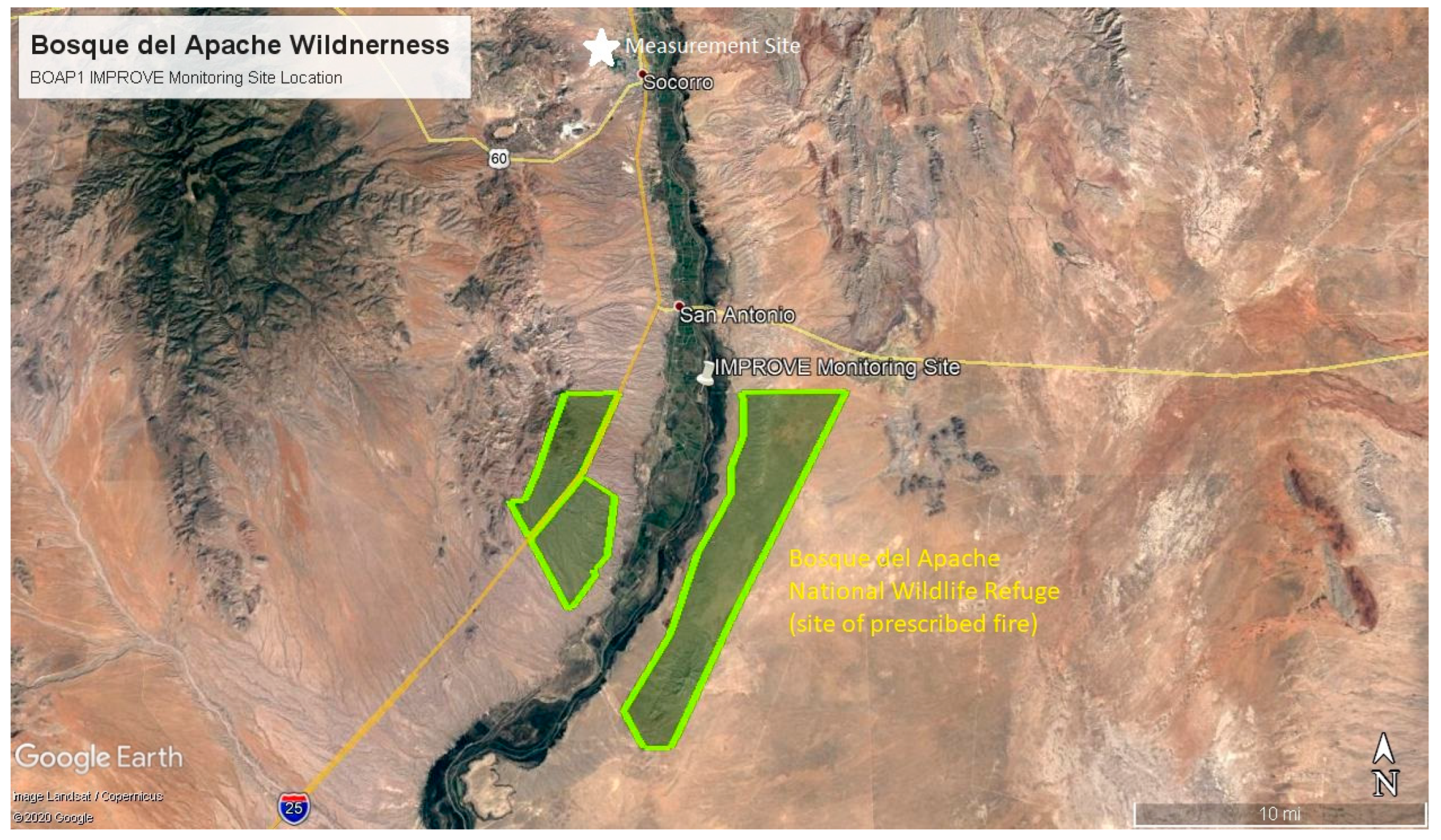
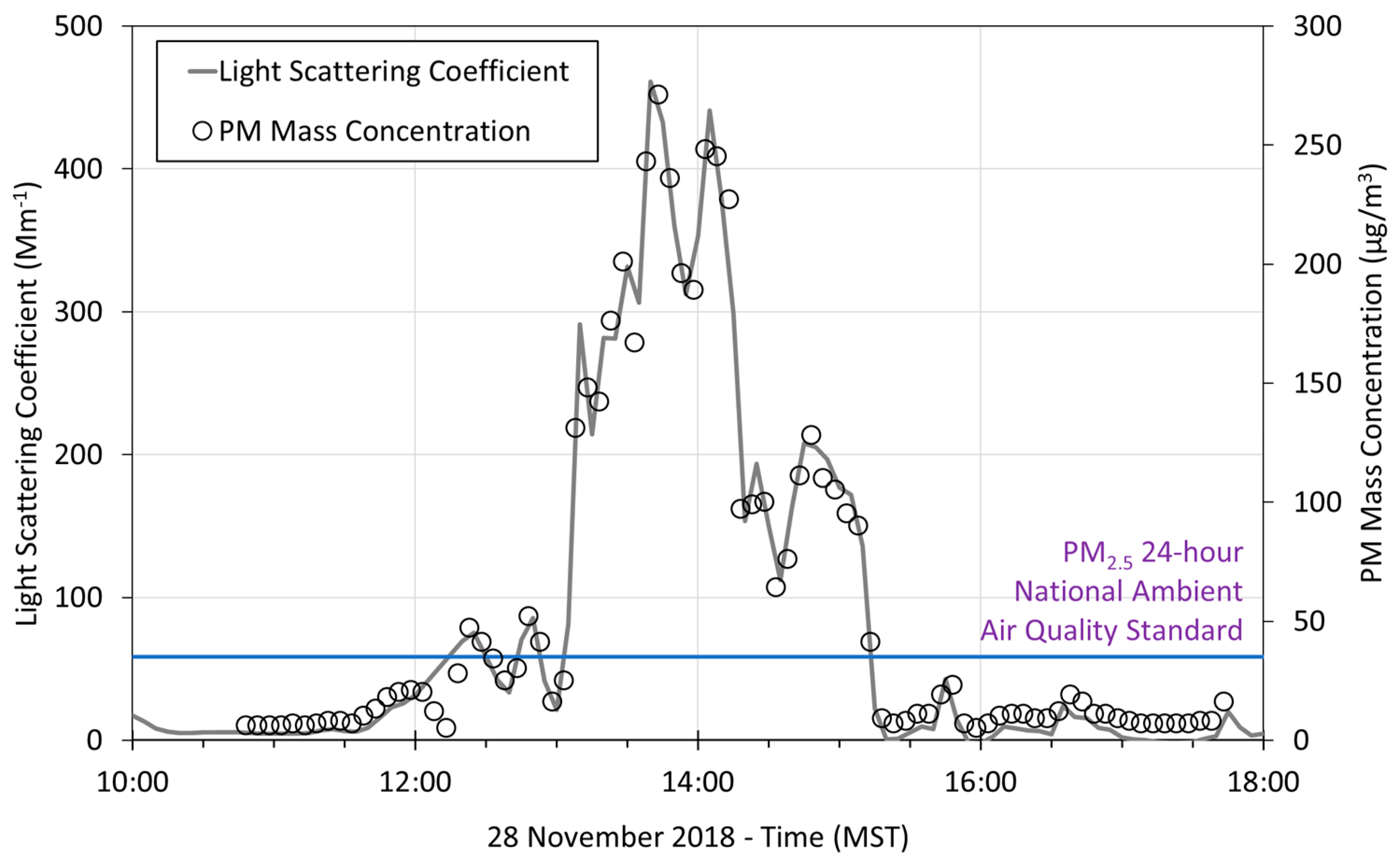
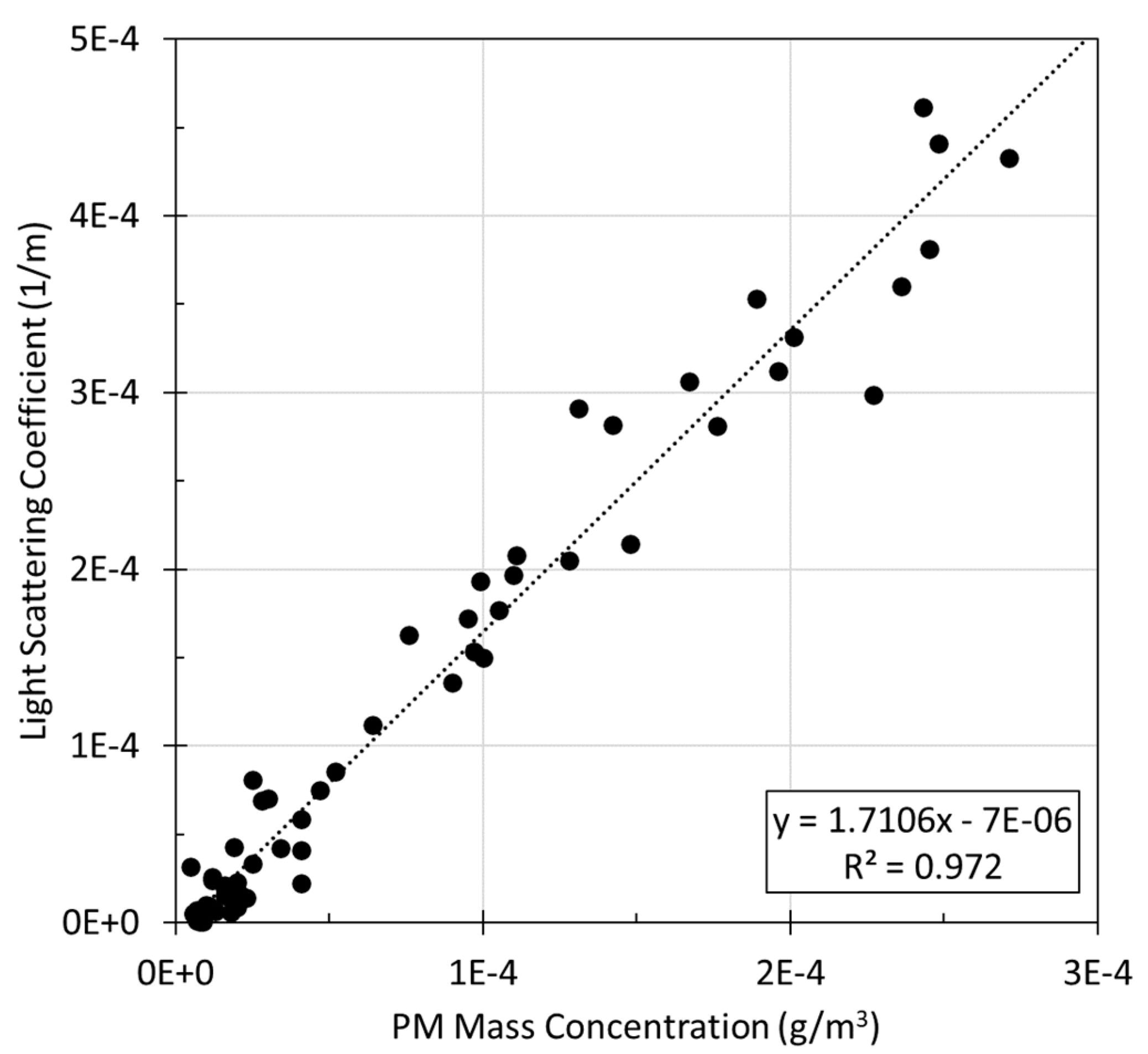
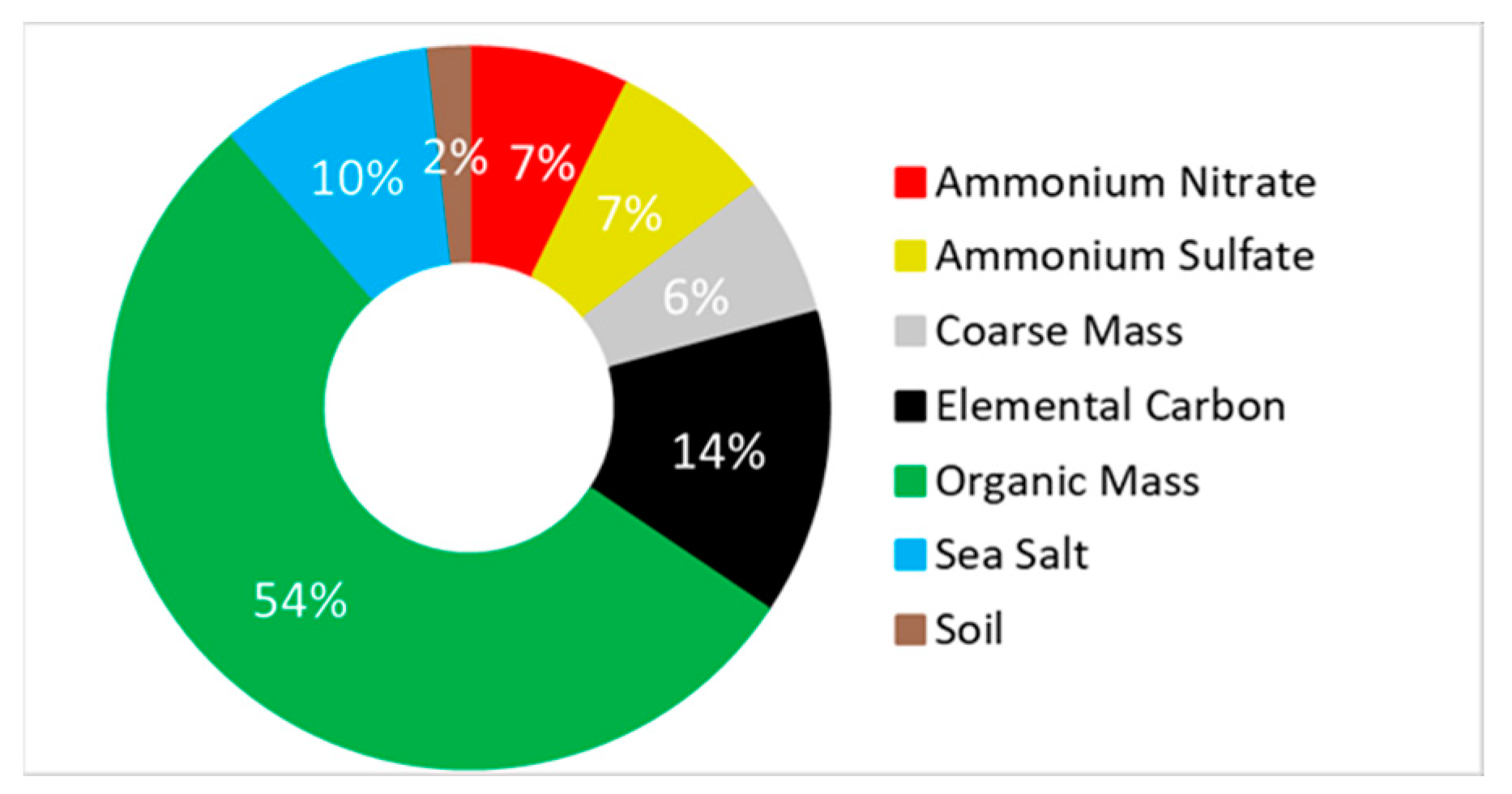
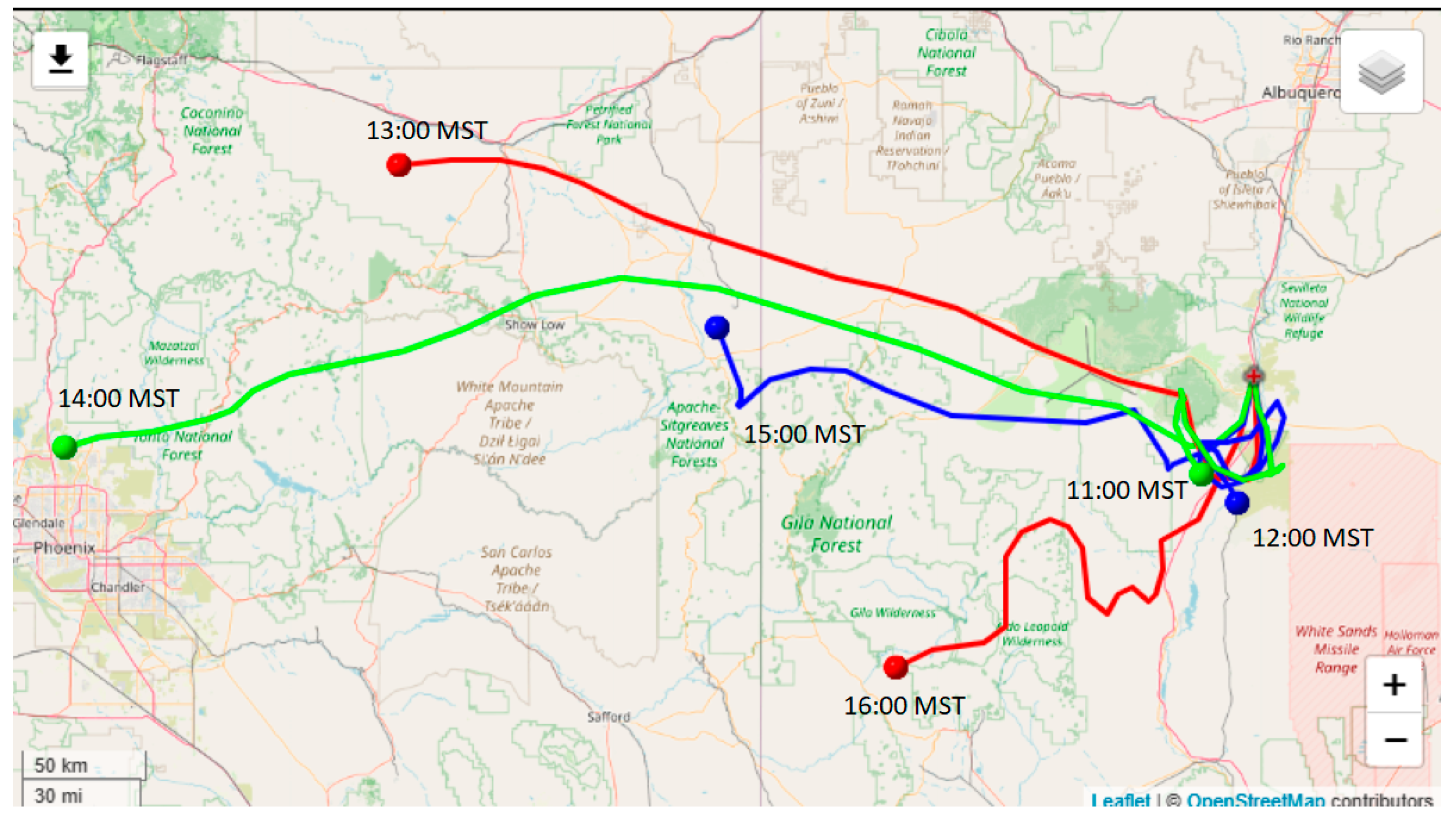
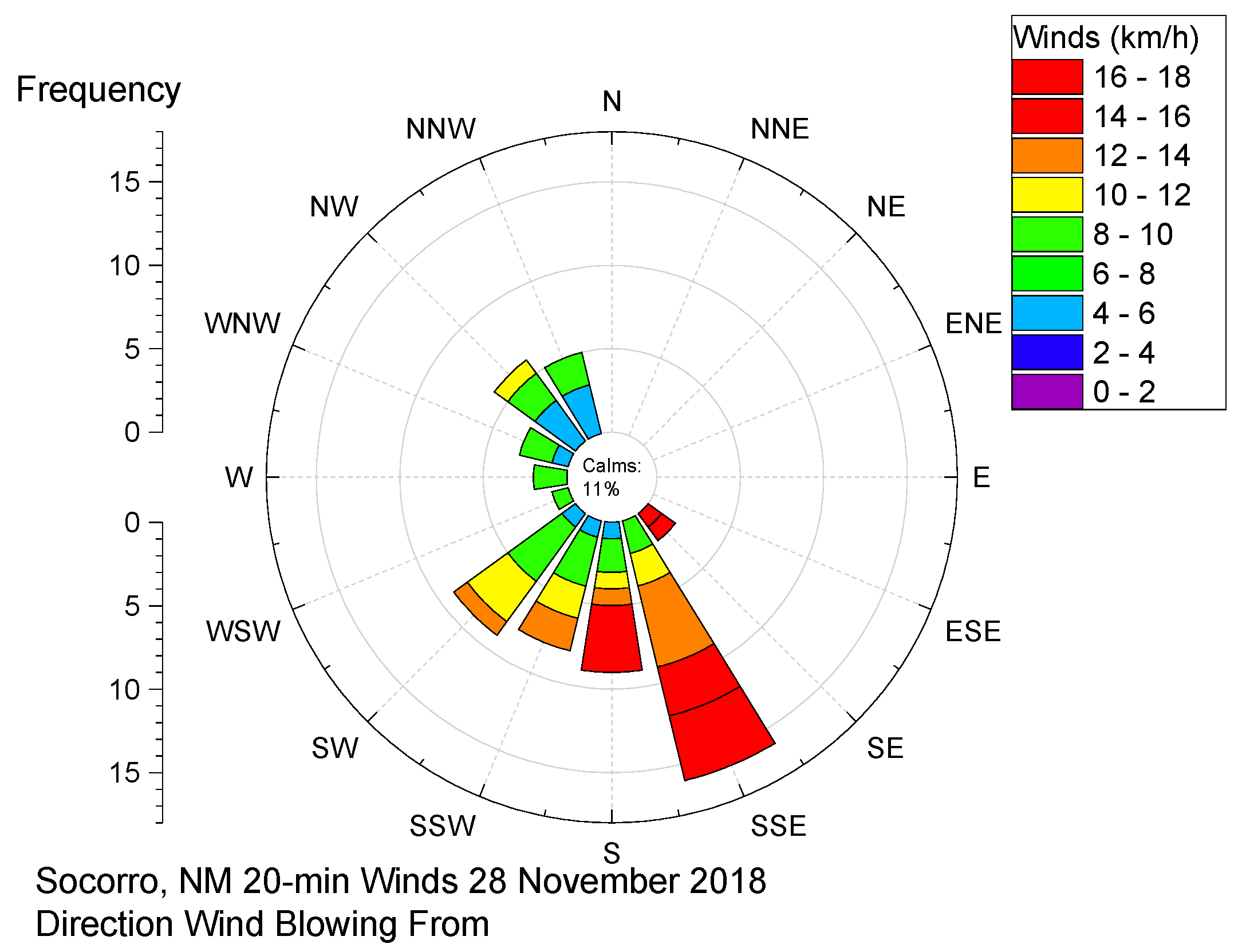
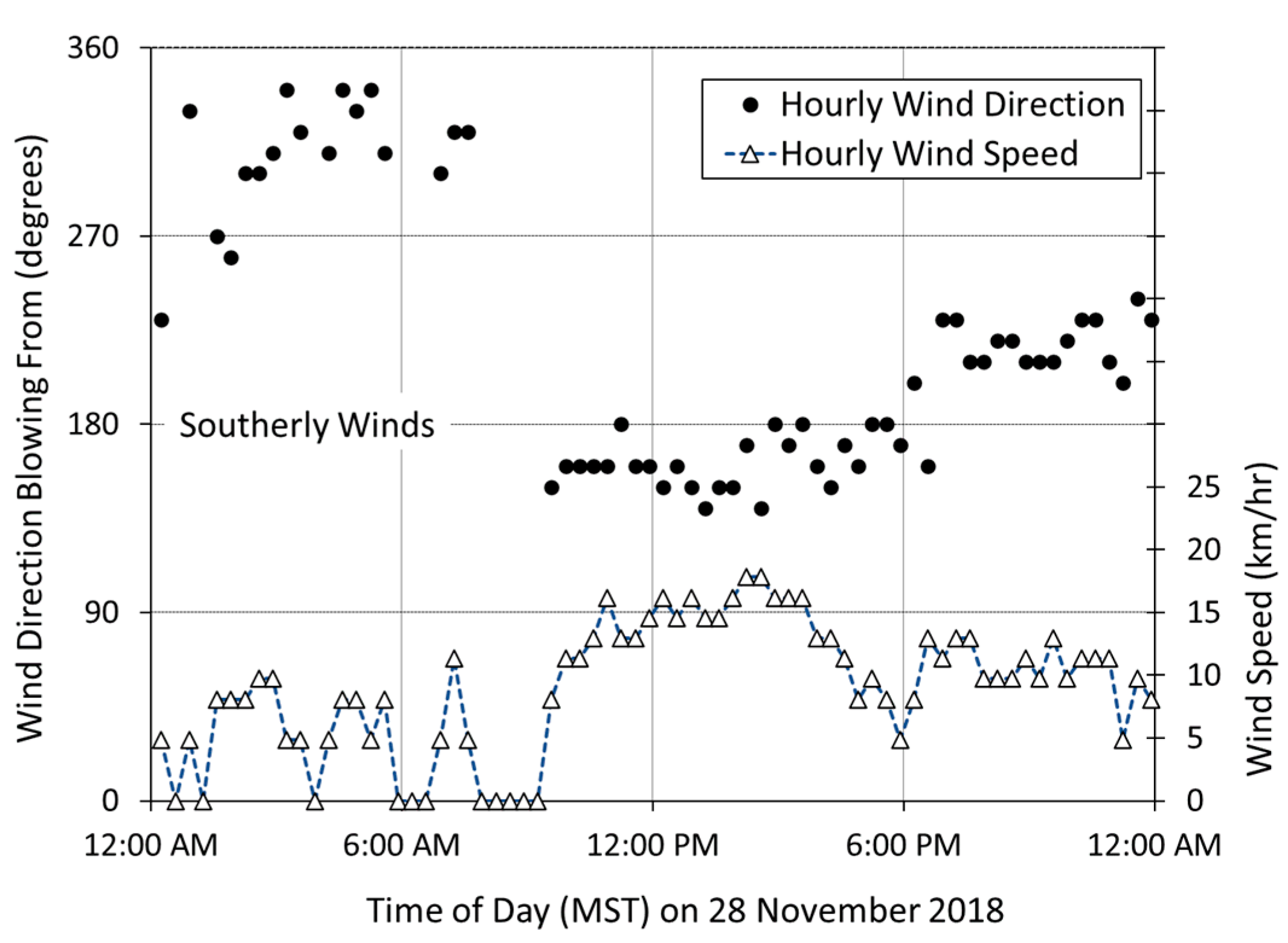

| Calibration Gas | Expected Response (Mm−1) * | Measured Mean (Mm−1) * | Measured Standard Deviation (Mm−1) |
|---|---|---|---|
| CO2 Span Gas | 19.4 | 18.6 | 3.2 |
| Particle-Free Air | 0 | 0.0 | −0.4 |
| Class 1 Area | IMPROVE Monitor | Light Extinction (Mm−1) |
|---|---|---|
| Bandelier Wilderness | BAND1 | 15.8 |
| Bosque del Apache Wilderness | BOAP1 | 76.9 |
| Carlsbad Caverns National Park | GUMO1 | 33.9 |
| Gila Wilderness | GICL1 | 13.8 |
| Salt Creek Wilderness | SACR1 | 22.0 |
| San Pedro Parks Wilderness | SAPE1 | 10.5 |
| Wheeler Peak Wilderness | WHPE1 | NA |
| White Mountain Wilderness | WHIT1 | 14.5 |
| Petrified Forest National Park (AZ) | PEFO1 | 16.8 |
| Mount Baldy (AZ) | BALD1 | 10.8 |
| Chiricahua (AZ) | CHIR1 | 16.7 |
| Grand Canyon National Park (AZ) | GRCA2 | 15.2 |
| Shamrock Mine (CO) | SHMI1 | 14.2 |
| Mesa Verde National Park (CO) | MESA1 | 13.2 |
| Weminuche Wilderness (CO) | WEMI1 | 13.4 |
| Great Sand Dunes N.M. (CO) | GRSA1 | 13.6 |
Disclaimer/Publisher’s Note: The statements, opinions and data contained in all publications are solely those of the individual author(s) and contributor(s) and not of MDPI and/or the editor(s). MDPI and/or the editor(s) disclaim responsibility for any injury to people or property resulting from any ideas, methods, instructions or products referred to in the content. |
© 2023 by the authors. Licensee MDPI, Basel, Switzerland. This article is an open access article distributed under the terms and conditions of the Creative Commons Attribution (CC BY) license (https://creativecommons.org/licenses/by/4.0/).
Share and Cite
Carrico, C.M.; Karacaoglu, J. Impacts of a Prescribed Fire on Air Quality in Central New Mexico. Atmosphere 2023, 14, 316. https://doi.org/10.3390/atmos14020316
Carrico CM, Karacaoglu J. Impacts of a Prescribed Fire on Air Quality in Central New Mexico. Atmosphere. 2023; 14(2):316. https://doi.org/10.3390/atmos14020316
Chicago/Turabian StyleCarrico, Christian M., and Jaimy Karacaoglu. 2023. "Impacts of a Prescribed Fire on Air Quality in Central New Mexico" Atmosphere 14, no. 2: 316. https://doi.org/10.3390/atmos14020316
APA StyleCarrico, C. M., & Karacaoglu, J. (2023). Impacts of a Prescribed Fire on Air Quality in Central New Mexico. Atmosphere, 14(2), 316. https://doi.org/10.3390/atmos14020316





